07.03.2006
Maxim Notkin. Spicy dessert
Those reading these reviews for long time, know that extensively analyzed Wijk aan Zee masterpieces will not be present here. By trial (please note, I do not mention errors, our work is perfect, without any false modesty) we arrived at the following formula: we praise spectacular games played in major tournaments and show that creative spirit is found not only in elite GMs rookeries.
The first game in this collection (finished 4th in the January list) was played in an open tournament. That was a strong tournament, and the game was played between two outstanding grandmasters. Viorel Bologan will annotate his victory over Viktor Korchnoi is the coming March issue of the "64" magazine, and he will certainly do it better than I. But please consider my notes a necessary preparation. Direct contact with dazzling beauty may harm the reader's health – it is just like glancing at the sun after long stay in darkness.
V.BOLOGAN – V.KORCHNOI
French defense С11
Gibraltar
1.e4 e6 2.d4 d5 3.¤c3 ¤f6 4.e5 ¤fd7 5.f4 c5 6.¤f3 ¤c6 7.Ґe3 ¦b8. In this variation, which is much less popular than 7...cxd4 and 7...a6, Black spends an extra tempo to prepare b7-b5, but leaves the a6-square vacant.
8.Јd2 Јa5 9.a3. Jakovenko – Zvjaginsev (Russian superfinal 2005) saw 9.Ґe2 b5 10.0-0 b4 11.¤d1, and Black exchanged bad French light-squared bishop by 11...Ґa6. This strategic aim was achieved similarly in another game, А.Zhigalko – Hertneck (San Vincent 2005): 9.Ґd3 c4 10.Ґe2 b5 11.0-0 b4 12.¤d1 h5 13.b3 ¤b6 14.¤f2 Ґa6 15.¤h3 c3 16.Јe1 Ґxe2 17.Јxe2 ¤e7, with complex game in both cases.
9...b5.

10.¦a2!? Ponomariov opted for the same way of defending against b5-b4 against Bareev in Khanty Mansiysk, and his win took the 3rd place in the December list.
10...c4. If 10...b4 11.axb4 Јxb4 12.b3, White's position should be preferred, as the a7-pawn is rather vulnerable.
11.f5 Ґe7 12.fxe6 fxe6 13.g3 0-0. Probably Korchnoi also considered an immediate 13...¤b6, but reasoned it is better to prevent the White's bishop from going to h3.
14.Ґg2 ¤b6 15.0-0 ¤a4 16.¤e2. White plans attacking the е6-pawn. In case of 16.¤xa4 Јxa4 he is unable to prevent b5-b4, thus Black obtains a counterplay on the queenside. An isolated pawn on a7 becomes a much less significant factor then, as the c4-pawn fixes a weakness on b2. Also possible is 16...Јxd2 17.¤xd2 ¦xf1+ 18.ўxf1 bxa4, and the White's rook is going to spend ages on a2, while a materialistic 19.¤xc4?? is refuted by 19...Ґa6.
16...Јxd2 17.Ґxd2.
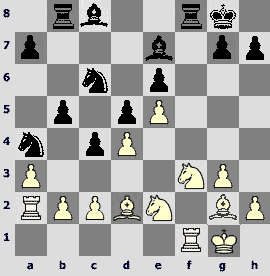
17...¤b6! It looked like the knight had come to an active position, however, Viktor L'vovich assesses the situation deeper, and immediately upon the swapping the queens sends the knight, which fulfilled its strategic duties, to protect the e6-pawn. Standing on a4, it only hampers a queenside pawn avalanche.
18.Ґh3. More precise 18.h4 would spare White a couple of tempi.
18...¤a8! 19.Ґg4. A completely unclear position emerges after 19.Ґb4 Ґxb4 20.axb4 ¤xb4 21.¦xa7 ¤xc2 22.¤g5 ¦xf1+ 23.ўxf1 b4. It looks like White risks much more. In case of 19.¤f4 ¤c7 20.Ґb4 Black could build up a good defense by 20...¤xb4 21.axb4 a6.
19...¤c7 20.h4 a5 21.c3 Ґd7. After 21...b4 22.axb4 axb4 23.¦fa1 White seizes the file. So Black should spend time preparing this advance.
22.¤f4 ¤d8. As it transpires from the next moves, Black fails to find an active plan. Maybe it was sensible to place the rook on f7, and not the knight. Although in any case White plays a more active role at this stage of the game.
23.¦aa1 ¤f7 24.Ґh3 ¦a8 25.g4 ¤d8 26.g5 ¤c6 27.¤h5 ўh8. White raised the siege of the e6-pawn, which frees the opponent's hands on the queenside. However, playing 27...b4 is still not good in view of 28.¤f6+! gxf6 29.gxf6 Ґd8 30.Ґh6.
28.¤f6!
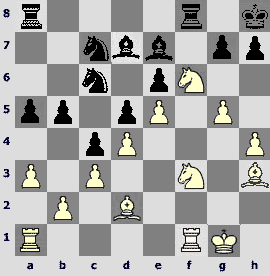
What an all-consuming strive for initiative! In addition, Viorel had to realize that he can't get by without the 33rd move, and this did not trouble him.
28...gxf6. Actually, Black has a spiteful 28...Ґc8 in his possession, asking the opponent to clarify his intentions. But of course accepting the sacrifice is more principled.
29.gxf6 ¦g8+ 30.ўh2 Ґf8 31.¤g5 ¤d8 32.Ґg4 h6.
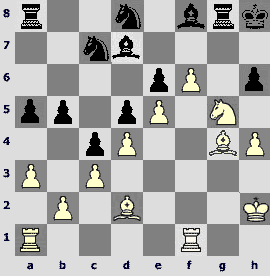
33.Ґh5! A brilliant sacrifice of the second knight, aiming at building a pawn structure named after Philidor.
33...hxg5 34.hxg5 (34.f7!? is also interesting) 34...Ґe8. Korchnoi makes the best defensive moves. After 34...ўh7? with a sensible idea of putting a rook to g6, White wins by 35.g6+ ¦xg6 36.Ґxg6+ ўxg6 37.f7!, and Black has to part with everything to avoid getting mated.
35.Ґxe8 ¤xe8 36.f7 ¤xf7 37.¦xf7 Ґg7 (otherwise ¦h1) 38.¦af1!? On 38.g6 or 38.¦f3 Black finds 38...¦f8. In case of 38.ўg3 ўh7 39.¦h1+ ўg6 40.¦e7 ¦a6 White has nothing better than 41.¦f1.
38...ўh7 39.¦e7 ¦a6 40.ўg3. In the variation 40.g6+!? ўxg6 41.¦f3 ¦h8+ 42.ўg2 White does not risk losing, despite being a piece down. However, hecannotplayforawin, too.
40...ўg6 41.ўg4 ¦c6. Black could straighten his shoulders a bit and activate the rook – 41...¦h8. It looks like Viktor L'vovich lost his concentration here. A time-trouble effect should not be disregarded as well.
42.¦ff7 ¦c8. With the White's rook arrived to f7, Black can remove the protection from the e6-pawn, but he must not forget about it completely.
43.¦b7.

43...¦h8? 43...Ґf8 was a must, at Black it not worse at least. Now a combined attack on the e6-pawn and the e8-knight succeeds.
44.¦fe7 ¦c6 45.Ґf4 a4 (Black cannot move) 46.¦bd7 ¦f8 47.¦d8 ¤c7.
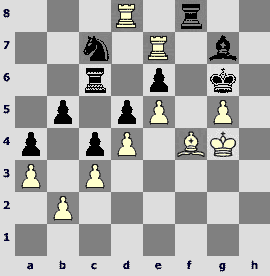
48.¦d6! Leads to decisive material gains, incidentally pleasing the observer.
48...¦xd6 (48...¦e8 49.¦xe8 ¦xd6 50.exd6 ¤xe8 51.d7 ¤f6+ 52.gxf6 Ґxf6 53.Ґc7) 49.exd6 ¤a6 50.¦xe6+ ўf7 51.¦e7+ ўg6 52.d7. With inevitable threats ¦e8 and ¦e6+. Black resigned. A colossal game!
In the next two games a more traditional endgame handling is featured.
M.GUREVICH – C.SANDIPAN
English opening А17
Gibraltar
1.c4 ¤f6 2.¤c3 e6 3.¤f3 Ґb4 4.Јc2 0-0 5.a3 Ґxc3 6.Јxc3 b6 7.e3 Ґb7 8.Ґe2 c5 9.b4 d6 10.Ґb2.
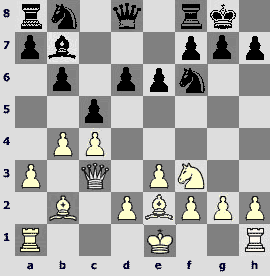
10...¤c6. I should say straight away that the young Indian player acts in the opening as if Black just needs to trade similar pieces to equalize. Such a strategy is especially harmful as his opponent often does not need any opening advantage to outplay a player less experienced in positional subtleties.
In the following game the experience/skill ration between White and Black was opposite, and Black quickly got an extra pawn and a better position – 10...¤bd7 11.0-0 e5 12.d3 Јe7 13.¤d2 d5 14.cxd5?! (14.bxc5 d4!) 14...¤xd5 15.Јc4 cxb4 16.Ґf3 ¦fc8 17.Јa2 ¤7f6 Ree – Euwe, Amsterdam 1973.
These are examples of White's successful play: 10...e5 11.0-0 ¦e8 12.¦ae1 (in the world championship in Las Vegas 1999, Kramnik got a better position against Adams after 12.d3 ¤bd7 13.¦fe1 a5 14.bxc5 bxc5 15.d4 ¤e4 16.Јc2 cxd4 17.exd4 ¤g5 18.¤xg5 Јxg5 19.d5) 12...¤bd7 13.d4 (the е2-bishop is protected, so White carries out a thematic advance) 13...¦c8 14.bxc5 bxc5 15.d5 ¤f8 16.¤d2 ¤g6 17.¦b1 ¦b8 18.Јc2 Јd7 19.¦fc1 Ґa6 20.Ґd1 ¦b6 21.Ґc3, M.Gurevich – Rozentalis, Germany 2001. White won is a slow maneuvering fashion that is so dear to Mikhail.
11.0-0 ¦e8 12.d4 cxd4 13.¤xd4 ¤xd4 14.Јxd4 d5 15.cxd5 Јxd5 16.Јxd5 ¤xd5 17.¦ac1 ¦ac8 18.¦fd1 ¦xc1 19.¦xc1 ¦c8 20.¦xc8+ Ґxc8.
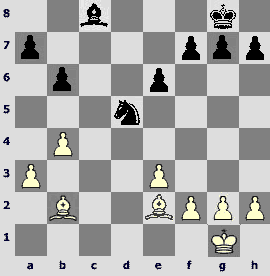
I have mentioned Sandipan's opening handling already. It seems like both players were eager to arrive at this position. It is easy for me to comment the subsequent play, but I suspect I would have more problems finding these moves at the board. And I am sure that Gurevich was finding them effortlessly. So, let us start with a textbook example of converting a two-bishop advantage.
21.e4 ¤e7 22.b5! (fixes black pawns, extends the range of the dark-squared bishop) 22...f6 (Black can't do without this move, in addition it helps to prevent the White's bishop invasion to b8) 23.Ґc3 ўf7 24.Ґc4 ¤g6 25.Ґb4 ¤e5 26.Ґe2 Ґb7 27.f3 ¤d7. If the king moves to d7, White plays Ґf8, forcing the kingside pawns to move thus providing the bishops with attacking objects.
28.Ґd6 g6. In case of 28...¤c5 one must take 29.Ґb8 into account. However, after 29...a5 30.Ґc7 (the knight cannot be cut off by 30.bxa6 Ґxa6 31.Ґxa6 ¤xa6 32.Ґd6 – the pawn ending after ¤c5 is lost, but Black just plays 32...e5 and ўe6) 30...¤a4! Whitecannotwinapawn – 31.Ґd1? ¤c3. 31.Ґd6 is possible, but I think Gurevich after quick look at these variations would have played a calm 29.Ґc4 or 29.ўf2. The a7-pawn will not escape.
29.ўf2 f5 (otherwise White would place the bishop to c4, the king to d4, and begin to push his pawn to f5) 30.exf5 gxf5. After 30...exf5 31.Ґc4+ ўf6 32.ўe3 g5 33.ўd4 the White's king has a free route to the queenside – Ґd5, trade the bishops and go ahead to the a7-pawn.
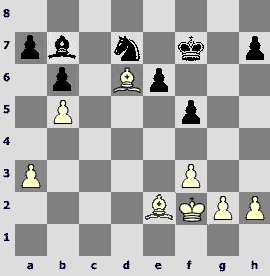
31.g4! Asymmetric pawn structure favors White.
31...fxg4. I would advise patience, even if only out of protest. Such moves as the text leave me with the impression that both players strive for the same result. More precisely, for the same position. However, any present-day Russian schoolboy familiar with books of Dvoretsky, Shereshevsky and Panchenko can tell that playing like this is a sure loss for Black.
32.fxg4 Ґd5. If 32...e5, then 33.Ґc4+ ўf6 34.ўe3 h6 35.h4 Ґc8 36.Ґc7 followed by Ґd8+ and g4-g5, and White creates a passed pawn.
33.ўe3 ўg6 34.h4 h6 35.h5+ ўg7 36.Ґg3 ¤f6 37.Ґe5 ўf7 38.Ґf4 ўg7.

One weakness is on а7, another one is on h6. The algorithm is very simple.
39.ўd4 ¤e4. After 39...¤d7 the following play is possible: 40.g5 hxg5 41.Ґxg5 ўh7 42.Ґd3+ ўg7 43.h6+ ўh8 44.Ґf4 Ґg2 45.Ґe5+ ¤xe5 46.ўxe5 Ґh3 47.ўd6, collecting Black's queenside, or 41...Ґb3 42.Ґf3 e5+ 43.ўc3 ¤c5 44.Ґc6 Ґf7 45.h6+ ўg6 46.Ґe3, and the threat Ґxc5 followed by the a-pawn march drives the knight away from c5.
40.Ґe5+ ўf7 41.Ґf4 ўg7 42.ўe5 ¤c3 43.Ґd3 Ґf3 44.ўd6 ¤a4 (bad is 44...ўf7 45.Ґg6+ ўg8 46.Ґe5 ¤e4+ 47.ўe7 ¤g5 48.Ґb8) 45.Ґe5+ ўg8.
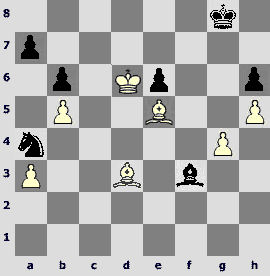
46.g5! The ring around the Black's king tightens, however, one should not rush with decisiveactions. Impatient 46.ўe7 allows Black to survive after 46...Ґxg4 47.Ґg6 ¤c5! 48.Ґf7+ ўh7, and then the saving ¤d7.
46...¤c5. Forced. Other moves lose on the spot: 46...hxg5 47.h6 or 46...Ґxh5 47.gxh6.
47.Ґg6 ¤e4+ 48.ўxe6 ¤xg5+ 49.ўe7. The number of paws on board is rapidly decreasing, but it does not bring Black the relief. He inevitably loses a pawn, after which he will face an unsolvable task to dealing with a distant passer.
49...Ґe2 50.Ґb8 a6 51.bxa6 Ґxa6 52.Ґa7 ¤f3. If 52...b5, then 53.Ґd3 Ґb7 54.Ґxb5 Ґf3 55.Ґe8 – the White's bishop makes it everywhere! And 53...¤f3 54.Ґe4 ¤g5 55.Ґd5+ ўh7 56.ўf8 leads to a mate.
53.Ґxb6 ¤e5 54.Ґe8 Ґc4 55.Ґd4 ¤d3 56.Ґe3 ўg7 57.a4 ¤b4 58.Ґd4+ ўg8 (after 58...ўh7 59.ўf8 Ґd3 60.Ґf7 the Black's king is getting mated) 59.a5 ¤d5+ 60.ўd6 ¤f4 61.Ґe3 ўf8 62.Ґc6 ¤xh5 63.Ґxh6+ ўf7.
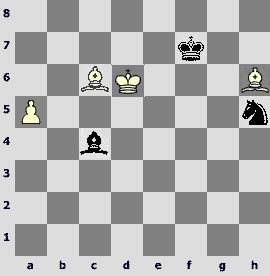
64.Ґd5+! Ґxd5 65.ўxd5. A culmination! Only a single white pawn has survived, but the knight is too far away from it. Black resigned.
When an experienced fighter demonstrates such a technique, you habitually admire it. But when you see it in a game of a small boy, you start speaking about leaders of the new generation.
M.CARLSEN – G.VESCOVI
Sicilian defense В46
Wijk aan Zee
1.e4 c5 2.¤f3 e6 3.d4 cxd4 4.¤xd4 ¤c6 5.¤c3 a6 6.¤xc6 bxc6 7.Ґd3 d5 8.0-0 ¤f6 9.¦e1 Ґe7 10.e5 ¤d7 11.Јg4 12.¤a4 Јa5 13.Ґh6 Јb4 14.Јxb4 Ґxb4 15.c3.
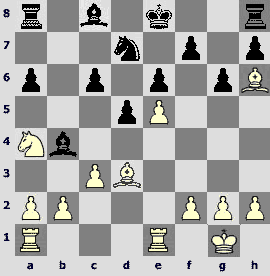
15...Ґf8. I won't go into theoretical details. It is enough mentioning that both players knew well Khanty Mansiysk game Bacrot – Rublevsky, in which after 15...Ґa5 16.b4 Ґc7 17.f4 a5 18.b5 ¤b6 the French player evaded a traditional way 19.¤c5 ¤d7 20.¤a4 ¤b6 21.¤c5 ¤d7 with a draw, Hazai – Romanishin, Sochi 1982, and used a novelty to beat a future Russian champion – 19.¤xb6 Ґxb6+ 20.ўf1 cxb5 21.Ґxb5+ Ґd7 22.¦ab1 ¦b8 23.c4 with advantage to White.
16.Ґxf8 ¦xf8 17.c4! ўe7. Perhaps a confirmed “Frenchman” would have tried to play f7-f6 as soon as possible. Now 17...f6 18.exf6 ¦xf6 19.cxd5 cxd5 20.¦ac1 looks too risky, but Black will have even fewer possibilities of freeing later on.
18.cxd5 cxd5 19.¦ac1 ¦a7. The bishop appearance should be prepared. Bad is19...Ґb7 20.¦c7.
20.b4! Ґb7 21.f4.
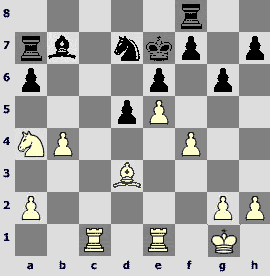
Magnus disposed the pawns correctly, having increased the pressure both in the center and on the queenside of the opponent's camp. The king's march to the epicenter is on the agenda.
21...¦c8 22.¦xc8 Ґxc8 23.¦c1 ўd8 24.ўf2 ¤b8. In case of 24...f6 25.exf6 ¤xf6 26.ўe3 a thematic break will provide the White's king with too many tempting squares.
25.¤c5 ¦c7 26.¦c2 ¤d7 27.¤b3. White has improved the knight's position. He is not afraid of exchanges because a bad bishop of the opponent remains on board.
27...¦xc2+ 28.Ґxc2 ¤b8. Again we try playing28...f6 29.exf6 ¤xf6 30.h3!? e5 31.fxe5 ¤d7 32.ўe3 ¤xe5 33.ўd4 ¤c6+ 34.ўc5, and again we see that in such an ending Black has little chances to survive.
29.¤d4 Ґd7 30.g4.
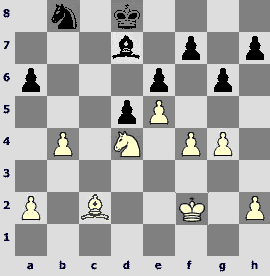
30...h6. Giovanni did not risk transiting into the bishop ending and he had reasons for that. On the other hand Black still has two passive pieces under the chosen method of defense. This is how the game could develop after the exchange of the knights: 30...¤c6 31.¤xc6+ Ґxc6 32.ўe3 Ґb5 33.g5 ўc7 34.Ґd1 Ґc4 35.a4 ўc6 36.ўd4 ўb6 37.h4 ўc6 38.h5 ўb6 39.h6 ўc6 40.Ґg4! Ґb3
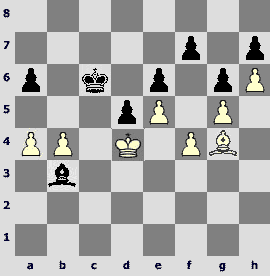
41.f5! exf5 42.Ґxf5! gxf5 (42...Ґxa4 43.e6) 43.e6 ўd6 (43...fxe6 44.g6) 44.exf7 ўe7 45.g6, and White wins. It's clear that I cannot guarantee the correctness of such a lengthy variation. Perhaps it was worth trying.
31.ўe3 ўc7. Here in case of 31...¤c6 32.¤xc6+ Ґxc6 33.Ґd3 the Black's bishop is driven to a passive position, as in the pawn ending White simply captures on b5 after 33...Ґb5? 34.Ґxb5 axb5 35.ўd4. There are no doubts that White is to win in case of 33...Ґb7 34.h4 ўc7 35.ўd4 ўb6 36.f5.
32.a4 ўb6 33.a5+ ўb7 34.Ґd3 Ґa4 35.Ґe2 ¤d7 36.h4 ¤b8 (there is no rescue also after 36...g5 37.h5!).
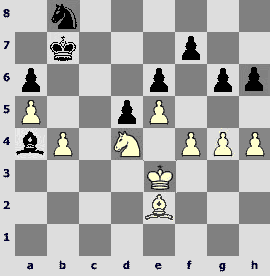
37.f5 gxf5 38.gxf5 Ґd7 39.Ґh5. Black resigned.
Let's go on to the spicy courses. Emil Sutovsky and Evgeny Najer liked a game of the Armenian team champion.
D.ARUTJUNIAN – L.BABUJIAN
Sicilian defense В42
Yerevan
1.e4 c5 2.¤f3 d6 3.d4 cxd4 4.¤xd4 a6 5.c4 ¤f6 6.¤c3 e6 7.Ґd3 ¤bd7 8.0-0 b6 9.Јe2 Ґb7 10.b3 Ґe7 11.Ґb2 Јc7 12.¦ac1.
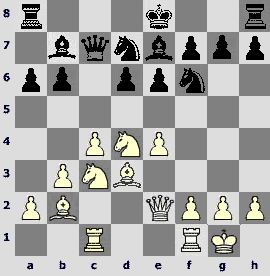
12...¤e5. The opening play reveals that the Black player is a passionate supporter of the Hedgehog. This version is not the most favourable as White has good attacking prospects on the kingside, however the desire for getting a favorite structure overweighs other arguments. There is no doubt that the Black's position has a certain margin of safety. In 2002 a German chessplayer Voigt continued 12...0-0 in this position and achieved a good game against Sax: 13.f4 h6 14.¦ce1 ¦fd8 15.Ґb1 ¤f8 16.ўh1 ¦ac8 17.f5 e5 18.¤d5 ¤xd5 19.exd5 Ґf6 20.¤f3 b5. Two years later Kritz played more energetically against Voigt in the German championship. Black poorly managed his pieces and lost quickly: 13.ўh1 ¦ac8 14.f4 Јb8 15.Ґb1 ¦fd8 (15...¦fe8) 16.g4 ¤f8 17.g5 ¤e8 (17...¤6d7) 18.h4 g6? 19.f5 d5 (на 19...gxf5 последует 20.¤d5) 20.fxe6 ¤xe6 21.¤xe6 fxe6 22.¤xd5 exd5 23.exd5 Јd6 24.Јf3, Black resigned. A move g7-g6 will also play a fatal role in this encounter.
13.f4 ¤xd3 14.Јxd3 g6?! Though White's decision of giving away a light-squared bishop is ambiguous, one still shouldn't underestimate his attacking chances. Black guessed wrong the last move. Certainly, there is a sound idea in it, but the opponent managed to expose its tactical drawbacks by the brilliant play. Better was 14...0-0 15.f5 e5 16.¤d5 Јd8 17.¤e2 (17.¤f3 b5) 17...¤xd5 18.cxd5 Ґg5.
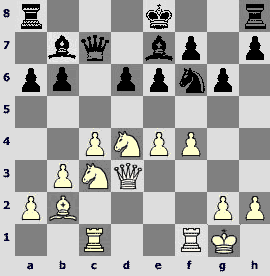
15.f5! gxf5 (15...e5 16.¤d5 Јd8 17.fxg6 hxg6 18.Јf3 exd4 19.Ґxd4 won'tdo) 16.¤d5! Black counted on 16.exf5 ¦g8 with a sample continuation 17.¦f2 e5 (a neat refutation 17...¤g4? – White makes a temporary rook sacrifice 18.fxe6! ¤xf2 19.exf7+ ўxf7 20.Јxh7+ ¦g7, giving also the queen for a moment – 21.Јxg7+! ўxg7 22.¤e6+, with material advantage) 18.¤d5 Јd8. Black had good chances in a complex struggle. Now White dictates terms.
16...Јd8. Forced. Too bad is 16...exd5 17.cxd5 Јd7 (17...fxe4 18.¦xc7 exd3 19.¦xb7) 18.¤xf5.
17.¤xf5! As the Olympic impressions are still fresh, White's sacrifices remind a chain of difficult elements in the figure skating. 17.Јh3 also deserved attention, adding to the threat of capture on f5. In any case 17...¦g8 will be followed by 18.¤xf5 exf5 19.Јxf5, however, Black holds the position having protected the f7-pawn with the help of 17...¦f8!
17...exf5 18.¦xf5 Ґxd5. In response to 18...¤xd5 White can think about 19.exd5 with subsequent ¦e1 or ¦cf1besides a simple 19.Ґxh8. It is unclear whether a passive light-squared bishop is more useful for defensive purposes than a temporally pinned knight.
19.exd5 ¦g8. In case of 19...¦f8 20.¦e1 ¤d7 21.Јh3 b5 White restores an approximate material balance by 22.Ґg7 keeping the initiative. 21...¤e5 loses: 22.Ґxe5 dxe5 23.¦fxe5 ¦a7 24.d6! Јxd6 25.Јc8+ Јd8 26.Јc6+ ¦d7 27.¦xe7+ Јxe7 28.¦xe7+ ўxe7 29.Јxb6.
20.¦e1. Giving away the f7-pawn is extremely risky for Black in case of 20.¦cf1 ¦g6 21.Јf3, but he can try seeking salvation in the rook ending after 21...b5 22.Ґxf6 Ґxf6 23.¦xf6 Јxf6 24.Јxf6 ¦xf6 25.¦xf6 bxc4 26.bxc4 (26.¦xd6 cxb3 27.axb3 ўe7 28.¦h6 ¦d8) 26...ўe7 27.¦f3 ¦c8 28.¦c3 ўf6. White, however, shows ambition.
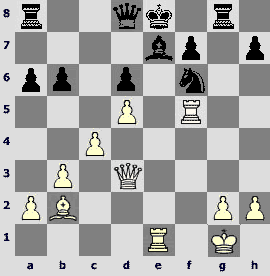
20...¤g4? Another knight retreat does not solve all the problems as well: 20...¤d7 21.Јf3! (excessively creative is 21.¦xf7!? ўxf7 22.Јxh7+ ўf8 23.Јh6+ ўe8 24.Јxd6!? b5 25.c5, however, it is within the realm of possibility; in the game Black made provisions for White not to have the ideas of that kind – the knight controls the h6-square from g4) 21...Јc7 22.Јh5! (stronger than 22.¦xf7 ¤e5 23.Ґxe5 dxe5 24.ўh1). Relatively better was 20...ўf8, once more dropping hints at the rook ending after 21.Јf3 ¦g6 22.¦f1 b5. There are chances to rescue also after 21.¦xe7 Јxe7 22.Ґxf6 Јd7.
21.h3. A move suggesting itself, however 21.Јh3! is probably stronger, and if 21...b5, there won't be 22.Јxh7 Јb6+ and 0-0-0 with unnecessary complications, but 22.¦e4, for example, 22...¤e5 23.Ґxe5 dxe5 24.¦fxe5 ¦a7 25.c5, and White has a dominating position.
21...¤h6 22.¦h5 ¦g6 23.Ґc1 ¤g8 24.¦xh7 ўf8. Black has regrouped and it is necessary to search for approaches to his fortifications again. 25.Јf3 or 25.¦f1 will be followed by 25...Ґf6.
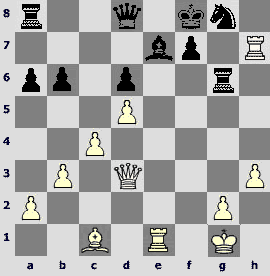
25.¦e6! Indeed, such an approach can crack the will of the defender!
25...¦f6? Correct is 25...¤f6 26.Јf5! (Black fights off in case of 26.¦h8+ ¦g8 27.Ґh6+ ўe8) 26...¤xh7 (one cannot hesitate – 26...b5 27.¦h8+ ¦g8 28.Ґh6+ ўe8 29.Јxf6!) 27.¦xg6 ¤f6 (the choice is not wide again: almost any queen retreat wins after 27...ўe8 28.¦g7 ¤f6 29.Ґb2 Јd7; 27...Јc8 28.Јf2 is also bad) 28.¦g3. Black is still in a difficult position, however, the defensive resources are not exhausted. Now White makes the opponent accept the rook sacrifice, meanwhile organizing a decisive invasion.
26.¦h8! fxe6 27.Јh7 ўe8 28.¦xg8+ Ґf8 29.Ґg5! exd5. 29...Јe7 30.Јxe7+ ўxe7 31.¦g6 leads to a lost ending.
30.Јg7. Cool 30.cxd5 emphasized Black's helplessness. Interesting is that all White's pieces are on the g-file.
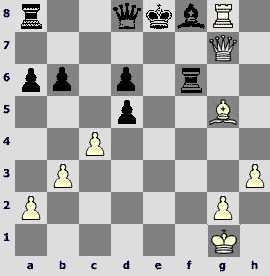
30...¦f7. Missing the last opportunity of complicating the opponent's task. After 30...Јe7 the transition into the ending is not that advantageous as it was a move before (Black had time to capture the pawn), however, after a simple capture of the rook White escapes numerous checks and wins: 31.Ґxf6 Јe3+ 32.ўf1 Јf4+ 33.ўe2 Јe4+ 34.ўd2 Јf4+ 35.ўc2 Јf2+ 36.ўd3 Јf1+ (36...Јf5+ 37.ўc3) 37.ўe3 Јe1+ 38.ўf3 Јe4+ 39.ўg3 Јe3+ 40.ўh4 Јf4+ 41.g4.
31.¦xf8+! ¦xf8 32.Ґxd8 ¦xd8 33.cxd5. The rest is quite easy.
33...¦d7 34.Јd4 b5 35.Јe3+ ўd8 (35...¦e7 36.Јc3) 36.Јb6+ ўe7 37.Јxa6 b4 38.Јe2+ ўd8 39.Јe4 ¦c7 40.Јxb4 ¦c5 41.Јd4 ¦f5 42.Јh8+ ўe7 43.Јh7+ ¦f7 44.Јe4+ ўd8 45.b4 ¦c1+ 46.ўh2 ¦cf1 47.a4 ¦1f4 48.Јe6 ¦7f6 49.Јg8+ ¦f8 50.Јg7 ¦8f7 51.Јh8+ ўe7 (51...¦f8 52.Јc3) 52.Јb8 ¦7f6 53.a5 ¦f2 54.a6 ¦a2 55.b5 ¦g6 56.Јa7+ ўd8 57.Јg1 ўc8 58.Јf1. Black resigned.
Another game from the Gibraltar open comes in conclusion. Despite the fact it was played in the last round when creative and physical strength seems to be on wane, both players showed remarkable inventiveness, and a more experienced player eventually turned out to be more successful in the tense struggle. I offer you an original commentary by grandmaster Golubev for daily Internet newspaper ChessToday (chief editor - grandmaster Alexander Baburin).
V.KORCHNOI – P.CARLSSON
Queen's Indian defense E15
Gibraltar
At the Gibraltar Masters event Viktor Korchnoi scored 6Ѕ/10, as well as GM Bologan and eleven other players. The combined age of three of them: GM Pelletier, GM Sandipan and IM Sundararajan is about level with the age of Korchnoi: a bit more or less - not easy to count precisely. Let's look at Korchnoi's win in the final round. 1.d4 ¤f6 2.c4 e6 3.¤f3 b6 4.g3 Ґa6
5.Јb3 Deviating from the very main lines with 5.b3. 5...¤c6 6.¤bd2 ¤a5 Also possible is 6...d5. The game Halkias-Mastrovasilis, Ech 2004 was annotated in CT–1299.
7.Јa4 A bit old-fashioned. 7.Јc3!?, which was first used in 2002, has been very topical of late.
7...c5?! An inaccuracy. Better is 7...Ґb7! 8.Ґg2 c5, which, by the way, was tested in Korchnoi-Bakre in the round 8 of the Gibraltar tournament: 9.dxc5 bxc5 10.0–0 Ґe7 (the theory considers 10...Јc7 to be equalising, but perhaps Korchnoi has his own view?) 11.¤e5 Ґxg2 12.ўxg2 0–0 13.¤df3 Јc7 14.Ґd2¤ ¤b7 15.Ґg5І . White won after a very long fight.
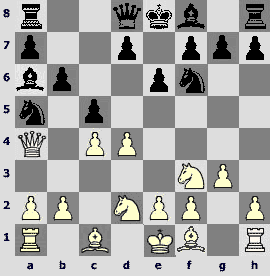
8.e4! 8...Ґb7 The natural looking 8...cxd4? loses material after 9.e5! (which is even stronger than 9.b4 Ґb7 10.bxa5 ¤xe4).
9.d5! exd5 10.exd5! In several preceding games White tried 10.cxd5, but I like Korchnoi's move better. 10...Јe7+ 11.Ґe2 Not 11.ўd1? ¤g4 and White loses his f2-pawn. 11...0–0–0
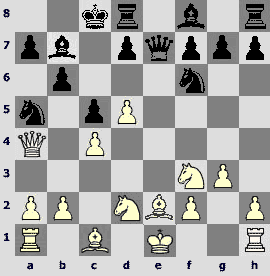
Now a curious situation has arisen: Black's pieces are placed quite poorly, but White can not castle easily. Still, I believe that he is better. After 11...g6 White could simply play 12.0–0! and 12...Јxe2 13.¦e1 loses a queen for Black.
12.ўd1! Great! After 12.¤f1 possible is 12...Јe4!?, creating the threat to the d5-pawn. If 12.ўf1, then after the approximate 12...g5 13.Ґd3 Ґg7 14.ўg2 g4 15.¤h4 Јe5 White can find that his king is in danger.
12...g5!? In the line 12...¤e4 13.¤xe4 Јxe4 14.Јc2! White stands clearly better.
13.Ґd3! After 13.h3 Black could try 13...g4!?
13...¤g4 14.¦f1! Instead, 14.¤e4 f5 15.Ґxg5 is rather double-edged.
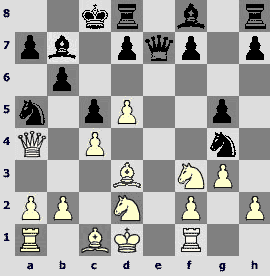
14...¤xf2+! 15.¦xf2 Јe3
Black has temporarily sacrificed his knight, but now he attacks two of white's pieces with his queen. Korchnoi faces a difficult choice, but again his move seems best.
16.b4! 16.¦e2 Јxd3 17.¦e4!? (intending to trap the queen by 18.¤e1) 17...¤xc4! (after 17...Ґc6?! White declines the offer by 18.Јc2!±) 18.¦xc4 (18.Јxc4 Јxc4 19.¦xc4 f6! with good compensation for the piece) 18...Ґxd5 (18...a6 19.Јb3 Јxb3+ 20.axb3 is better for White than in the previous note) 19.¤e1 Јg6!? 20.Јxa7 Ґg7, and the incredibly powerful light-squared bishop on d5 ensures compensation for Black. Also 16.¦f1 Јxd3 17.Јc2! (17.¤e5 Јd4 18.¤xf7 favors Black after 18...Ґxd5!) 17...Јg6! (but not 17...Јxc2+ 18.ўxc2 f6 19.b3± with strong pressure) 18.Јxg6 hxg6! results in a position with mutual chances.
16...Ґg7 16...cxb4!? deserved attention as well. Then 17.Ґb2! Ґc5 18.¦f1!? (18.¦e2 Јxd3 19.Ґxh8 ¦xh8 20.¤e5 Јd4 21.Јxd7+ ўb8чis messy) 18...Јxd3 19.¤e5 Јe3 20.¦e1! Јf2 21.¤d3! ¤xc4! 22.¤xc4 Јf3+ 23.ўc2 Јxd5 and Black is in the game, but, perhaps, White should be somewhat better here.
17.bxa5! Ґxa1 18.axb6 axb6
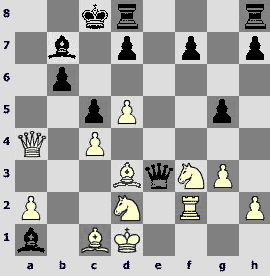
19.¤e4! Јxd3+ 20.¤fd2 Ґe5?! One of the better ideas was 20...ўc7!? 21.d6+ (or maybe first 21.¦f3) 21...ўb8 22.¦f3 Јd4 23.Јb5! (in other lines I see only a draw for White) 23...Јg1+ and, if wishes to play for a win, White can try 24.¦f1!?. Instead, 24.ўc2 Ґxe4+ 25.¤xe4 Јg2+ 26.¤d2 ўb7 (or maybe even 26...ўa7 ) 27.a4 (after 27.Ґa3 Ґd4 28.Ґb4!? cxb4 29.Јd5+ ўb8! 30.Јxd4 ўa7 it is not easy for White to attack) 27...g4! results in a draw: 28.Ґa3 (or 28.a5 gxf3=) 28...Ґd4! (not 28...gxf3?? 29.Ґxc5+-) 29.a5 gxf3 30.Јxb6+=.
21.¦f3? Pity! 21.Ґb2! would have lead to a big and possibly decisive advantage for White. 21...Ґxb2 (after 21...d6 22.Ґxe5 dxe5 23.¦f6! wins) 22.¦f3! (less clear is 22.¤d6+ ўb8 23.¤b5) and if Black gives away the queen he is in clear trouble, while 22...Јd4 loses after the approximate 23.¤d6+ ўb8 24.¤b5 Јg1+ 25.¦f1 Јxh2 26.Јa7+ ўc8 27.¤d6+ ўc7 28.Јxb7+ ўxd6 29.Јxb6+ ўe7 30.¦e1+.
21...Јd4 22.Јb5 Now the position is probably dynamically balanced.
22...¦he8 Or 22...f5!? 23.Јxb6 (if 23.¤xg5 ¦hf8 24.Јxb6 ¦f6!) 23...fxe4 24.¦b3 ¦df8! 25.Ґb2 Јg1+ 26.ўc2 Ґxb2 27.¦xb2 Јd4! and I suspect that 28.d6! (28.Јxb7+?! ўd8 29.¦b6 Јd3+ 30.ўc1 Јc3+ followed by 31...e3!) 28...Јd3+ 29.ўc1 ¦f1+! 30.¤xf1 Јxf1+ is a draw, no matter computer say. Black should be able to capture the c4 pawn with a check soon, but to get then to a4 or d5 with a check (followed by ...Јc6! - this is the only winning idea) seems to be impossible for him.
23.Јxb6 Perhaps the great fighter Korchnoi was not sure that Black was able to survive after this. Otherwise he could have tried 23.¤xg5!?
23...Ґc7
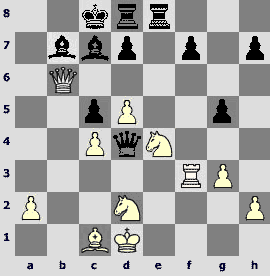
24.¤d6+! Only Black could be better after 24.Јb5 ¦xe4 25.¦b3 Јg1+!? (25...¦de8 26.Јxb7+ ўd8 27.Ґb2 and Black can force a draw by 27...Јxd2+!? 28.ўxd2 ¦e2+ 29.ўd1 ¦e1+ 30.ўc2 ¦8e2+!=) 26.ўc2 ¦xc4+!і with the idea of 27.¤xc4 Јg2+, capturing the d5 pawn.
24...Ґxd6 25.¦b3 25.Јxd6?? may look OK, but in fact it loses to 25...¦e6!, winning the queen.

25...¦e1+?? A desperate and losing attempt. We may suspect that Black was in the deep time trouble at this point. After 25...Ґxd5! I, honestly, do not see any ideas for White other than to give a perpetual check: 26.cxd5 (or 26.Јa6+ ўc7=; 26.Јxd6?? loses to 26...Ґf3+) 26...Јxd5 27.Јa6+ ўc7 28.Јa7+ (or 28.Јa5+), etc.
26.ўxe1 Јg1+ 27.¤f1!+- ¦e8+ 28.¦e3 (28.Ґe3! wins on the spot) 28...¦e6?! (28...Ґe5 could have prolonged the game a bit. But, obviously, Black is lost anyway) 29.dxe6 Ґg2 30.Јxd6
Black resigned
